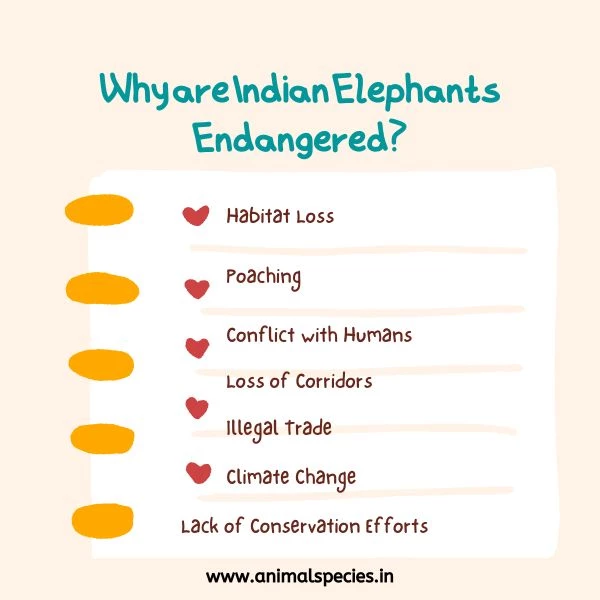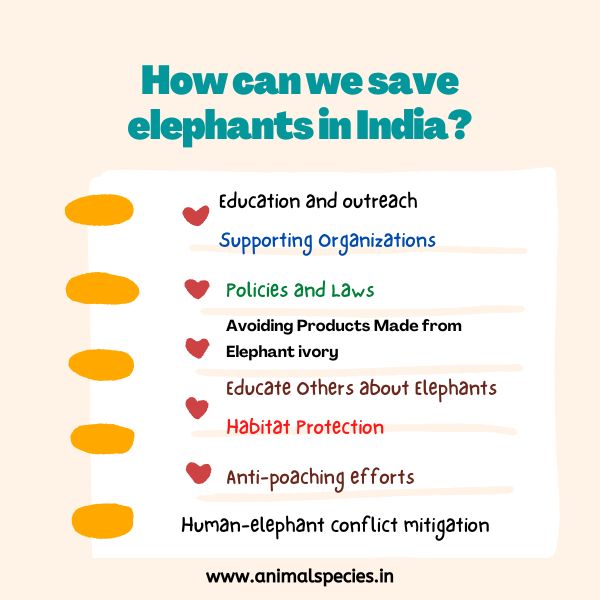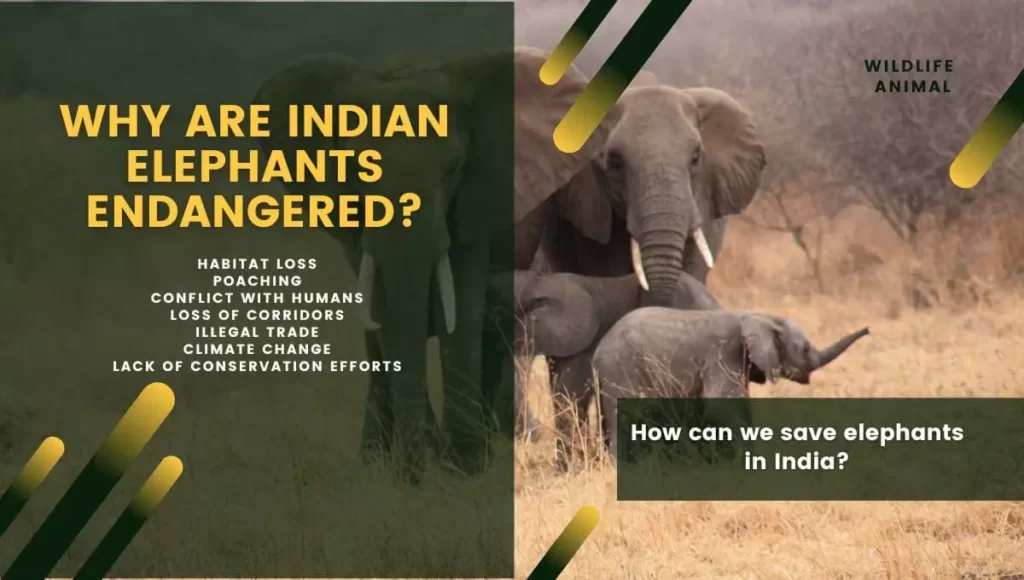Indian elephants are endangered due to a variety of factors, including habitat loss, poaching, Loss of Corridors, Illegal Trade, Climate Change, Lack of Conservation Efforts, and conflict with humans.
Why are Indian elephants endangered?

There are several other factors that contribute to the endangerment of Indian elephants.
No 1. Habitat Loss:
Habitat loss is a major threat to Indian elephants, as the expansion of agriculture and urbanization has led to the destruction of their natural habitats.
This has resulted in a fragmentation of the elephant population, making it harder for Indian Elephants to find suitable places to live and reproduce.
No 2. Poaching:
Poaching is also a significant threat to Indian elephants, as their tusks are highly valued on the black market.
In addition, elephants are often killed for their meat, which is considered a delicacy in some parts of the world.
No 3. Conflict with Humans:
Finally, conflict with humans is also a major factor in the endangerment of Indian elephants.
As human populations have grown and come into closer contact with elephants, incidents of conflict have increased.
Elephants may damage crops and cause other problems for farmers, leading to retaliation.
Overall, the combination of these factors has contributed to the declining population of Indian elephants, which is why they are considered endangered.
No 4. Loss of Corridors:
One is the loss of corridors, which are the paths that elephants use to migrate between different habitats.
These corridors are often disrupted or blocked by human development, making it difficult for elephants to move between different areas.
No 5. Illegal Trade in Elephants:
Another factor is the illegal trade in elephants, both for their tusks and for use in the tourism and entertainment industries.
This trade can lead to the capture and exploitation of elephants, which can have negative impacts on their health and well-being.
No 6. Climate Change:
Climate change is also a concern for Indian elephants, as it can affect the availability of food and water, as well as the distribution of diseases.
No 7. Lack of Conservation Efforts:
Finally, the lack of effective conservation efforts and inadequate protection for elephants and their habitats also contribute to their endangerment.
Overall, it is important to address these various issues in order to help protect and preserve the remaining population of Indian elephants.
How can we save elephants in India?

There are several ways that people can help to protect and conserve Indian elephants.
1 Supporting Organizations:
One way is by supporting organizations that work on elephant conservation and habitat protection, either through donations or by volunteering time and skills.
2. Policies and Laws:
Another way to help is by advocating for stronger conservation policies and laws, and by supporting efforts to combat poaching and the illegal trade in elephants.
This can include supporting organizations that work to combat these issues, and by raising awareness about the importance of protecting elephants and their habitats.
3. Avoiding Products Made from Elephant ivory:
It is also important to be mindful of the impact of personal choices, such as avoiding products made from elephant ivory and supporting eco-tourism initiatives that prioritize the well-being of elephants and their habitats.
4. Educate Others about Elephants:
Finally, it is important to educate others about the importance of conserving Indian elephants and the challenges they face.
This can include sharing information about elephant conservation with friends and family, and participating in events and campaigns that raise awareness about the issue.
By taking these steps, individuals can help to protect and conserve Indian elephants, and contribute to the overall efforts to preserve these important and iconic animals.
5. Habitat protection:
There are several ongoing conservation efforts to protect Indian elephants and their habitats. These efforts include:
Many organizations work to protect and preserve the natural habitats of Indian elephants, including forests, grasslands, and wetlands.
This can involve creating protected areas for elephants, such as national parks and wildlife reserves, as well as working to restore and rehabilitate damaged or degraded habitats.
6. Anti-poaching efforts:
Organizations such as the Wildlife Trust of India work to combat poaching and the illegal trade in elephants, through efforts such as training and equipping rangers, monitoring elephant populations, and working with local communities to reduce demand for illegal wildlife products.
7. Human-elephant conflict mitigation:
Many organizations work to address the conflict between humans and elephants, which can involve efforts such as building elephant-proof fences to protect crops, providing compensation to farmers for losses due to elephant damage, and working with local communities to find solutions that benefit both humans and elephants.
8. Education and outreach:
Many organizations also focus on educating the public about the importance of elephant conservation, and raising awareness about the challenges that elephants face.
This can involve working with schools and local communities, as well as participating in public events and campaigns.
Last Word:
Overall, these efforts aim to protect and conserve Indian elephants and their habitats, and to find ways to coexist with these animals in a sustainable way.

